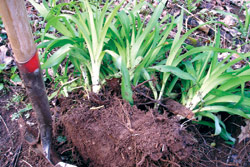My recent article on redoing my cottage garden (“The Aging Ageless Jardin,” March 25 Xpress), prompted lots of phone calls, e-mails and texts (sorry—I don’t answer those) all delivering the same message: Please don’t destroy your cottage garden! But, they went on, if you’re so heartless as to continue with your plan, well, what are you going to do with all those plants?

I suspect they weren’t nearly as interested in my garden’s survival as they were in making one of their own. Face it: When it comes to our neighbors’ plants, we gardeners are a greedy lot. I should know. I wouldn’t have a garden were it not for the generosity of friends who recognized my envy and gave me a snippet before I could sneak into their gardens at midnight, shovel in hand.
Besides, I’m not totally destroying my garden, just making it more manageable. Some of those plants will be redistributed around my house. I’ve also potted a lot of plants and might try to sell them. (Is this a shameless plug for a budding nursery in Leicester? Let’s see if the editors will leave it in.) Still others will be shared: Stephanie, a newly married and newly gardening friend, will get hollyhocks and Siberian iris for her fence line. My mother’s shady garage area will benefit from my hostas and astilbes, and my foxgloves will grace a neighbor’s wooded lot.
But the really great thing about gardening is that plants love to re-seed, self-layer, produce offsets and generally reward the gardener—and the gardener’s friends—by creating new plants with relative ease. When I first began gardening in earnest, I took on the title of “household propagator.” Aiming to fill our little spot on earth with as many plants as was humanly possible, I layered forsythias till my husband said: “Really; I mean, really. Where do we put another one?”
I liked the fact that bending a forsythia limb down and covering it up with dirt could produce an entirely new plant. How cool is that? Now, all my friends have forsythia in their yards, courtesy of moi. I bought rooting hormone and took cuttings of everything from rhododendrons to Russian sage—basically every woody stem in my yard. The sage was a huge success, the rhododendrons not so much. Now, those same friends have Russian sage with their forsythia.
Re-seeding works even better. Let the plant reproduce itself, giving you a ton more plants. Columbine and common grape hyacinths are great re-seeders. So yes, my friends now have those flowers their yards too. See how generous I am?
My all-time favorite way to get new plants, though, is what I’m doing now: dividing. Perennial herbaceous plants need to be divided about every three to five years. This reinvigorates them, producing new growth and prettier blooms. It also allows for better air circulation and light in your garden, producing better blooms and discouraging diseases. Best of all, it instantly gives you fully mature new plants: no waiting for seedlings to germinate or stem cuttings to root. Just dig up your perennial, divide it, and voilà!—four plants instead of one.
Consider my astilbes. I began with five each of white, pink and burgundy; I now have more than 60 astilbes, and this year, I’m dividing them again—a few each day. I’ll soon have more than 200 plants, and by the end of this month, they will cover a perfect, shady, completely overgrown bank that I have.
So here’s what you do. Examine your garden bed for plants that have gotten too big and clumpy. If the plant has grown in girth, is taking up more room than it should, has skimpy flowers or a bare middle, it’s time to divide. Dig up your plant with a flat-edged shovel, taking care not to damage the roots. Then, using the same shovel or a really good garden knife, cut it into four sections. (You can do more than four, but too small isn’t good, so four is the rule of thumb.). Replant them—or, if your garden is too full, pot them and hand them out to friends. Now, when plants are just emerging, is the best time of year to divide them. (If it’s a spring-blooming flower, divide it in the fall, but make sure the plant is secure and well-mulched to avoid frost-heaving.)
So what are you waiting for? Grab a shovel and see what needs dividing in your yard. Oh, and let me know: You might have something I absolutely need
[Cinthia Milner lives in Leicester.]



Before you comment
The comments section is here to provide a platform for civil dialogue on the issues we face together as a local community. Xpress is committed to offering this platform for all voices, but when the tone of the discussion gets nasty or strays off topic, we believe many people choose not to participate. Xpress editors are determined to moderate comments to ensure a constructive interchange is maintained. All comments judged not to be in keeping with the spirit of civil discourse will be removed and repeat violators will be banned. See here for our terms of service. Thank you for being part of this effort to promote respectful discussion.